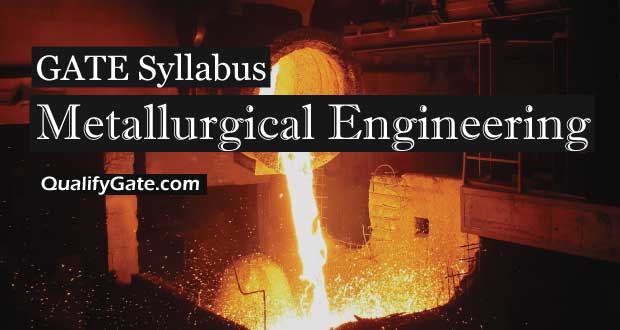PDF download link of GATE 2021 Syllabus for Metallurgical Engineering (MT) is given in the end of the article.
Syllabus for General Aptitude (GA) (common to all papers)
Section 1: Engineering Mathematics
Linear Algebra: Matrices and Determinants, Systems of linear equations, Eigen values and Eigen vectors.
Calculus: Limit, Continuity and Differentiability; Partial derivatives; Maxima and minima; Sequences and series; Test for convergence; Fourier series.
Vector Calculus: Gradient; Divergence and Curl; Line, Surface and volume integrals; Stokes, Gauss and Green’s theorems.
Differential Equations: Linear and non-linear first order ODEs; Higher order linear ODEs with constant coefficients; Cauchy’s and Euler’s equations; Laplace transforms; PDEs –Laplace, one dimensional heat and wave equations.
Probability and Statistics: Definitions of probability and sampling theorems, conditional probability, Mean, median, mode and standard deviation; Random variables; Poisson, normal and binomial distributions; Analysis of experimental data; linear least squares method.
Numerical Methods: Solutions of linear and non-linear (Bisection, Secant, Newton- Raphson methods) algebraic equations; integration by trapezoidal and Simpson’s rule; single and multistep methods for differential equations.
GATE 2021 Syllabus for Metallurgical Engineering
Section 2: Metallurgical Thermodynamics
Laws of thermodynamics: First law – energy conservation, Second law – entropy; Enthalpy, Gibbs and Helmholtz free energy; Maxwell’s relations; Chemical potential; Applications to metallurgical systems, solutions, ideal and regular solutions; Gibbs phase rule, phase equilibria, binary phase diagram and lever rule, free-energy vs. composition diagrams; Equilibrium constant, Activity, Ellingham and phase stability diagrams; Thermodynamics of point defects, surfaces and interfaces, adsorption and segregation phenomena.
Electrochemistry: Single electrode potential, Electrochemical cells, Nernst equation, Potential pH diagrams.
Section 3: Transport Phenomena and Rate Processes
Momentum transfer: Concept of viscosity, shell balances, Bernoulli’s equation, mechanical energy balance equation, flow past plane surfaces and through pipes.
Heat transfer: Conduction, Fourier’s Law, 1-D steady state conduction.
Convection: Heat transfer coefficient relations for forced convection.
Radiation: Black body radiation, Stefan-Boltzman Law, Kirchhoff’s Law.
Mass transfer: Diffusion and Fick’s laws, Mass transfer coefficients.
Dimensional analysis: Buckingham Pi theorem, Significance of dimensionless numbers.
Basic laws of chemical kinetics: First order reactions, reaction rate constant, Arrhenius relation, heterogeneous reactions, oxidation kinetics.
Electrochemical kinetics: Polarization.
GATE 2021 Syllabus for Metallurgical Engineering
Section 4: Mineral Processing and Extractive Metallurgy
Comminution techniques, Size classification, Flotation, Gravity and other methods of mineral beneficiation; Agglomeration: sintering, pelletizing and briquetting.
Material and Energy balances in metallurgical processes; Principles and processes for the extraction of non-ferrous metals – aluminum, copper and titanium.
Iron and steel making: Material and heat balance in blast furnace; Structure and properties of slags and molten salts – basicity of slags – sulphide and phosphate capacity of slags; Production of metallurgical coke. Other methods of iron making (COREX, MIDRE)
Primary steel making: Basic oxygen furnace, process dynamics, oxidation reactions, electric arc furnace.
Secondary steel making: Ladle process – deoxidation, argon stirring, desulphurization, inclusion shape control, principles of degassing methods; Basics of stainless steel manufacturing.
Continuous Casting: Fluid flow in the tundish and mould, heat transfer in the mould, segregation, inclusion control.
GATE 2021 Syllabus for Metallurgical Engineering
Section 5: Physical Metallurgy
Chemical Bonding: Ionic, covalent, metallic, and secondary bonding in materials, Crystal structure of solids – metals and alloys, ionic and covalent solids, and polymers.
X-ray Diffraction – Bragg’s law, optical metallography, principles of SEM imaging.
Crystal Imperfections: Point, line and surface defects; Coherent, semi-coherent and incoherent interfaces.
Diffusion in solids: Diffusion equation, steady state and error function solutions; Exampleshomogenenization and carburization; Kirkendall effect; Uphill diffusion; Atomic models for interstitial and substitutional diffusion; Pipe diffusion and grain boundary diffusion.
Phase transformation: Driving force, Homogeneous and heterogeneous nucleation, growth Kinetics Solidification in isomorphous, eutectic and peritectic systems, cast structures and macrosegregation, dendritic solidification and constitutional supercooling, coring and microsegregation.
Solid state transformations: Precipitation, spinoidal decomposition, ordering, massive transformation, discontinuous precipitation, eutectoid transformation, diffusionless transformations; Precipitate coarsening, Gibbs-Thomson effect.
Principles of heat treatment of steels, TTT and CCT diagrams; Surface hardening treatments; Recovery, recrystallization and grain growth; Heat treatment of cast iron and aluminium alloys.
Electronic, magnetic and optical properties of materials. Basic forms of corrosion and its prevention
GATE 2021 Syllabus for Metallurgical Engineering
Section 6: Mechanical Metallurgy
Strain tensor and stress tensor, Representation by Mohr’s circle, elasticity, stiffness and compliance tensor, Yield criteria, Plastic deformation by slip and twinning.
Dislocation theory: Edge, screw and mixed dislocations, source and multiplication of dislocations, stress fields around dislocations; Partial dislocations, dislocation interactions and reactions.
Strengthening mechanisms: Work/strain hardening, strengthening due to grain boundaries, solid solution, precipitation and dispersion. Fracture behaviour, Griffith theory, linear elastic fracture mechanics, fracture toughness, fractography, ductile to brittle transition.
Fatigue: Cyclic stress strain behaviour – low and high cycle fatigue, crack growth.
Mechanisms of high temperature deformation and failure; creep and stress rupture, stress exponent and activation energy.
Section 7: Manufacturing Processes
Metal casting: Mould design involving feeding, gating and risering, casting practices, casting defects.
Hot, warm and cold working of metals: Metal forming – fundamentals of metal forming processes of rolling, forging, extrusion, wire drawing and sheet metal forming, defects in forming.
Metal joining: Principles of soldering, brazing and welding, welding metallurgy, defects in welded joints in steels and aluminum alloys.
Powder metallurgy: production of powders, compaction and sintering.
Non-destructive Testing (NDT): Dye-penetrant, ultrasonic, radiography, eddy current, acoustic emission and magnetic particle inspection methods.

